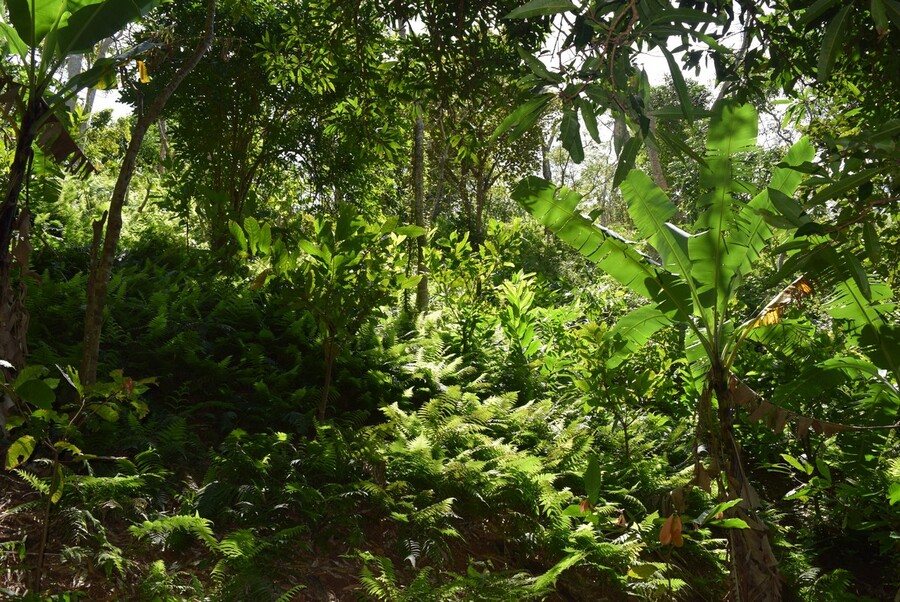6. Day – A paradise and an idea with consequences
The last few days I have been traveling a lot and have been so tired at night that I just fell into my bed. But to start at the beginning – on Monday (22.08.2016) we visited the land of Martial who switched to dynamic agroforestry in the beginning of 2015. To go there our way led us through a barren and cut down countryside. As soon as we entered Martials property, the world changed. Suddenly, we were standing in a green paradise. The parcel is located at an incline with a slope of partly 80 %. However, everything was green, the land was covered with ferns and lots of other plants, some big trees cast shadow and everywhere you could see a lot of young plants – a green paradise.
The young plants that we planted 18 month ago with almost 20 cm hight were now standing there rich and powerful with a height of 1 to 2 m. Especially noticeable was that all young trees, whether cacao, coffee, or carnation have been growing particularly good when they are standing next to big, old trees. Two cacao trees even bear fruits – after 18 month! Normally cacao bears fruits for the first time after about three years. If only Nestlé would listen to me. Two years ago they have equipped more than 30.000 farmers at the Ivory Cost with turbo cacao plants that depend on chemistry, a base that does not create a green paradise, but short-term top-class performance in monoculture. But the time will come, I am sure.
10 more hectare for the dynamic agroforestry
On our way back through the barren, cut down and hot countryside, I came up with an idea: “Is there someone here that might be interested in changing his ruined land into a green paradise with the help of the dynamic agroforestry?”
We shortly discussed my proposal and than Dorian took his phone and called someone. “How many hectare do you need at least?”, he asked me. "10 hectare", I said, without knowing, if it is true, just a good feeling. The mayor of Ambavalala is interested, said Dorian and looked at me. Upps, that was going quickly. Ok, so we are going to meet the mayor now.
And that was how it happend. Two bottles of cola and two hours later we had his assurance to change 10 hectare of municipal land to dynamic agroforestry. The mayor has seen what we achieved in pilot plots like the one of Martial and has become curious. Besides, he loves nature.
Off road to Diego
The following two days (23. and 24.) we spent in the car to get from Sambava to Antisirana (shortly called Diego) 400 km to the north. 168 km off-road. The rally Paris-Dakar is nothing against that, at least in my opinion. I could hardly believe, what narrow ways next to deep holes a jeep is able to drive or from what angle a jeep can come upright again. The boys, Jimmy and Nasser, are doing the trip 6 to 8 times a year, two days one way. Even on the asphalted streets you need a lot of driving skills and calm nerves. There are deep potholes everywhere and sometimes the asphalt is just a rag rug. But still, we all take a deep breath as soon as we exchange the adventurous street of sand for the asphalt full of holes.
Deforestation, fire and cattle are always a problem
On Thursday (25.) we drove from Diego to our second project location in Ramena in the far north of Madagascar and directly at the sea. Again, I experience a completely new vegetation, this time a forest on sand. However, the problems are still the same: deforestation, fire and cattle. 10 years ago MBG and the local municipals have built a natural reserve, category 5 of the IUCN-criterias. The hazards of deforestation and fire are – almost – eliminated. However, still innumerable goats and some cattle are roaming about the forest. When we are driving with the jeep on the sandy track, you can see bizarre trees and flowers everywhere. During a stop at the seafront, we see wonderful beaches, abandoned military complexes and a sea turtle.
Farmer Landry tells his story
Outside the Nationalpark we are visiting a farmer, who changed his plot to dynamic agroforestry 16 month ago. Again we enter a green paradise, even here in this world of sand.
When I am asking the farmer if he could share some of his experiences about the method in a video, he does not want to stop talking. There are so many things to say, so many things he discovered over the last few month, for example that baobabs need sun or that he could sell the fruits of a bush of pots (like peas and very popular) already 2 month after the change.
Best wishes from the Indian Sea!

